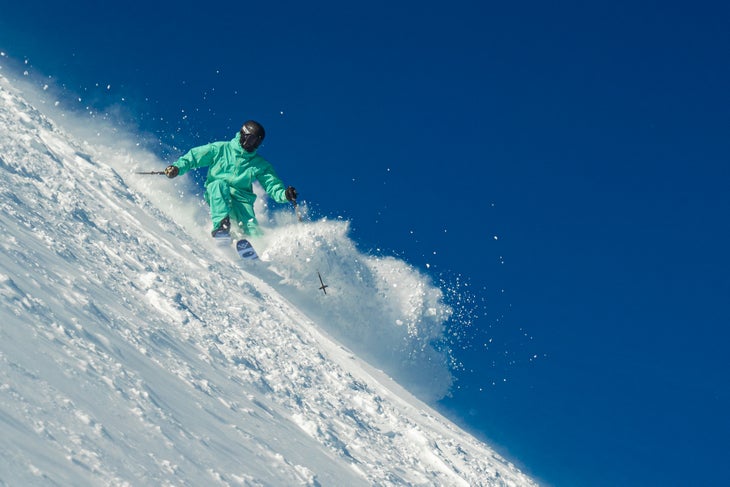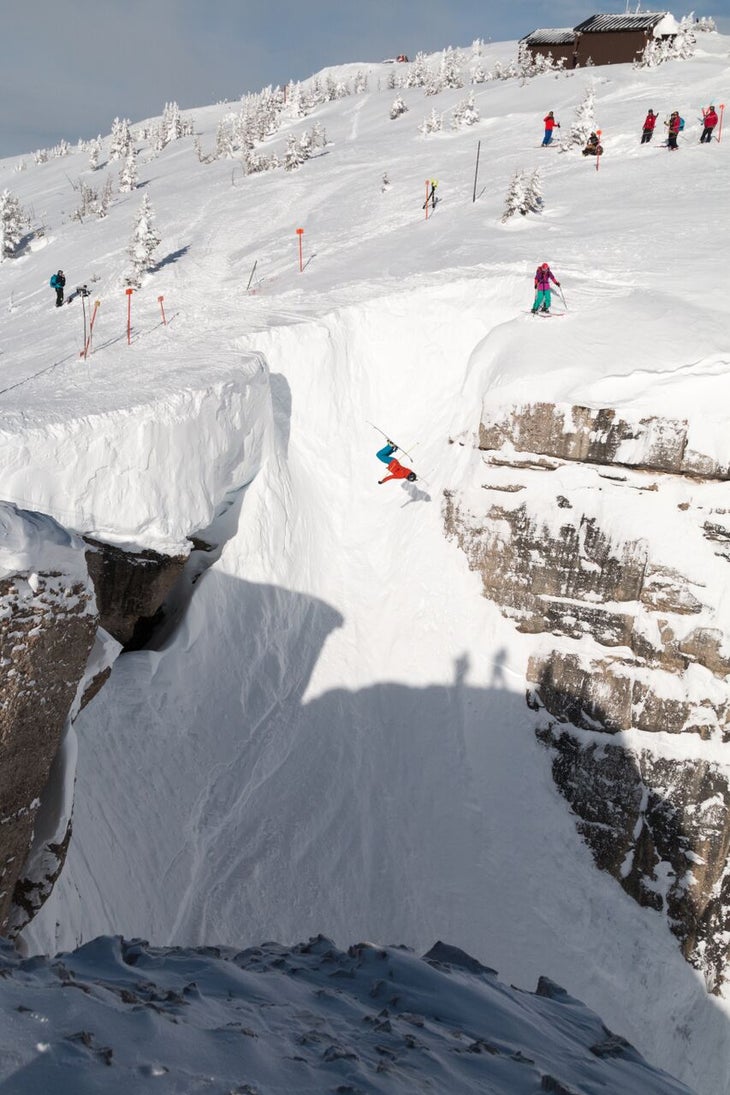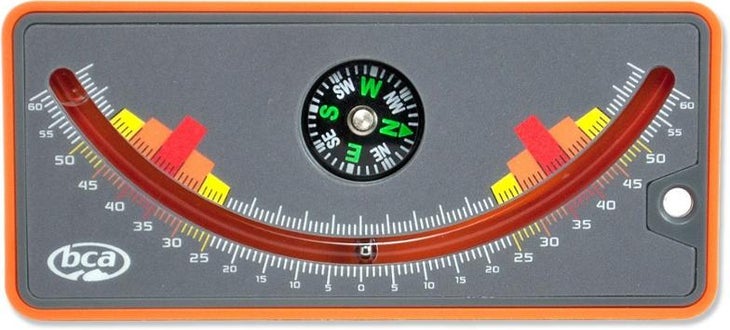Heading out the door? Read this article on the new Outside+ app available now on iOS devices for members! Download the app.
As my friend Raoul and I stand squinting into a thick gray fog that fills an unmarked chute near Zurs, Austria, the inevitable question arises: “How steep you think this sucker is?” he asks with a nervous chuckle. “I don’t have a clue,” I reply.
It isn’t the answer he wants to hear, but it’s true. I haven’t skied the run before, we’re off the trail map and visibility is limited to about 6 feet. All we really know is that the terrain is steep and the snow is stable. So we drop in and Braille our way down, one giddy, free-falling turn at a time. And at the bottom the question still remains. How steep was that?
It’s an issue that confronts every skier, whether it’s the first-day beginner who views the bunny hill as a thinly disguised cliff, or the wanna-be extremist who’s trying to convince his buds that he’s skied more radical lines than they have. It also crosses the minds of many skiers when they study the trail map of a new area and wonder, what exactly does a black diamond mean here?
Slope angle is relative

As anyone soon discovers after skiing a few resorts, the way a mountain rates its runs is more relative to its own terrain than to other areas’ slopes. A few double-blacks at Vail would barely be single-blacks in Whistler. And, of course, one man’s ceiling is another man’s floor. Chris Stagg, star ski instructor and resort executive at Taos, N.M., where more than half the runs are black or double-black, says, “I start introducing skiers to the steeps on the middle of Al’s Run, where it’s just over 30 degrees.” Most serious steep-hounds don’t really get interested until the pitch goes over 45 degrees.
Related: 5 Seriously Steep Eastern Runs
In addition to pitch, there are lots of variables that determine what makes one steep run more demanding than another. As skiers quickly learn, 45 degrees of blue ice is always going to ski harder than 45 degrees of foot-deep powder. A tight plunge through the trees on something like Telluride’s Zulu Queen or Stowe’s Goat will present different challenges than carving down a big bowl of the same steepness. Couloirs and liftlines have a psych-out component; bumps are gnarlier than corduroy; and long, sustained steeps are harder than shorter, but steeper, shots.
Read more: How to Ski Steeps
It still helps to know, however, just how steep a run is. Common visuals in a lift-ride discussion of “steeps” run the gamut from staircases to elevator shafts. I’ve equated runs to fire-poles and windshields and even resorted to calling S1 on Aspen Mountain “steeper than the drink prices in town.” One of my favorite images comes from an anecdote about early trail-clearing on Aspen Highlands, where one chainsaw-er referred to a pitch as “steep as a cow’s forehead, and her a-grazin’.”
A good metaphor can get the message across, yet still not give you specific information. For that reason, a lot of resorts rely on numbers, usually the degree of the pitch coupled with some colorful prose. A Big Sky press kit a couple of years ago read: “Most Testosterone-Charged Run Off the Tram: the Big Couloir, approximately 42 degrees. Steepest Way Down: Castro’s Shoulder, at 50 Degrees.”
Maximum skiable slope angle
The limit? Top alpinists these days are working pitches in the low to mid-60 degrees, but on anything much steeper, it becomes very difficult to maintain your ski’s contact with the snow. In fact, snow’s “angle of repose,” the greatest tilt at which snow can stick to the slope, is, at most, 75 or so degrees.

Understanding overall average steepness
“Overall average steepness” is the most common way of rating pitch these days, and probably is the fairest in terms of comparing runs to each other. But skier beware: Averages can be misleading. Does the slope you’re eyeing noodle along at a meek 25 degrees, then require a three-story cliff jump to achieve a 40-degree “overall average”? Consider America’s arguably most notorious steep slope, Corbet’s Couloir, whose average steepness of 40 degrees doesn’t tell the whole story. Jackson Hole, however, does give full disclosure, so as not to trap the unwary. “A classic ski run, the couloir is world-renowned for its nearly vertical entrance, steep pitch and variable conditions. Corbet’s degree of steepness is nearly vertical at the top, thus creating the need to jump into the couloir. The slope then ‘flattens’ to 50 degrees. The overall average steepness is 40 degrees.”
To help cover some of these contingencies, the ski patrol at Aspen Highlands has put out an award-winning “Extreme Guide” trail map to some of the ski area’s most difficult terrain. It lists the steepest pitch, average pitch and aspect (the direction the slope faces), for each of more than 50 expert routes. Among the sheerest are B-Cliffs in the Steeplechase area, with an average pitch of 46 degrees, and Go-Go Gully in Highland Bowl, with an average of 42 degrees-but with one section that tilts in at a full 48.
Not everyone, however, fully embraces empirical data. They worry about where and when measurements are taken. Readings at Aspen Highlands are done in summer and Kevin Heineken, Highland Bowl patrol director, says some areas may be steeper in winter due to cornicing, while others may be blown in and a little gentler.
Some resorts prefer an old-school approach that ignores the clinometer entirely. On the trail map at La Grave, France, they’ve gotten so pithy that they just use big yellow exclamation points to delineate extreme terrain.
Mad River Glen in Vermont, where 40 percent of the terrain is advanced, has an interactive trail map on its website where you can point and click at runs to bring up photos and thumbnail assessments. “Gazelle-most difficult. Super-steep and usually scratchy up top, nice bumps on the rest. Better ski it well since you’ll have a big audience above on the Sunnyside double.” It may help the new Mad River visitor to know that of all 20-plus black runs at the famously demanding resort, a number are categorized as “most difficult,” many are called “steep,” but only Gazelle is labeled “super-steep.” Mad River may figure that ignorance is bliss: No degree-of-pitch figures are given.
My neighbor, former extreme skiing World Champion Chris Davenport, knows the steeps intimately. He says of rating pitches by degrees: “I don’t really buy that stuff. There’s a lot of inconsistencies.” How, then, does he gauge steepness? “Basically, if I have to think twice before dropping in, it’s steep for me. Usually things that are only moderately steep you can just ski right down.” Then he adds, “When it’s the steepest, I’ll use my uphill hand against the snow, to feel where it is and give me more stability. And that’s when you know it’s fairly vertical, because otherwise you wouldn’t be able to touch the snow without falling over.”
In the end, Davenport uses the same phrase a lot of us use to refer to something truly precipitous, the same one I used with my friend Raoul in Zurs: “It’s really f—— steep.” And Chris thinks that measurement may be as good as any. “When you have to use an expletive to describe a run, now that’s steep.”
How is slope steepness calculated?

The instrument used to derive slope angles is called a “clinometer.” The company Backcountry Access makes a small, trail-map-sized Slope Meter for recreational use. (Put the device on a ski pole and place it on the fall line to get your reading.) Some ski patrols employ a more sophisticated device that calculates pitch by sighting the horizon and nearby objects.
Available on Amazon:
BCA Slope Meter
PIEPS 30 Degree Plus XT Inclinometer
Is slope angle calculated in degrees or percent?
Slope steepness is calculated in degrees and percent, though skiers generally use degrees. A 45-degree pitch is equivalent to a 100-percent grade, and both mean that a run descends one vertical foot for each horizontal foot. “In perspective, a very steep highway-pass road is approximately 7 percent or about 4 degrees,” according to the Highlands Extreme Guide trail map. My carpenter friends who also teach skiing like to tell their students that the incline of a standard house stairs is 30-35 degrees, which seems mild enough on the way to breakfast-but not when you’re looking down the Nose of the Headwall at Squaw.
Ready to challenge yourself on some seriously steep terrain this season? Enroll in SKI and AIM AdventureU’s newest online course “Mastering Steeps” and get step-by-step instruction on the techniques and tactics you need to best these heart-pounding runs this season. Sign on at skimag.com/masteringsteeps.
This article was originally written by Jay Cowan and published in the December 2001 issue of Skiing Magazine. It has since been updated by SKImag.com Editors to include additional information on the topic of slope angle.